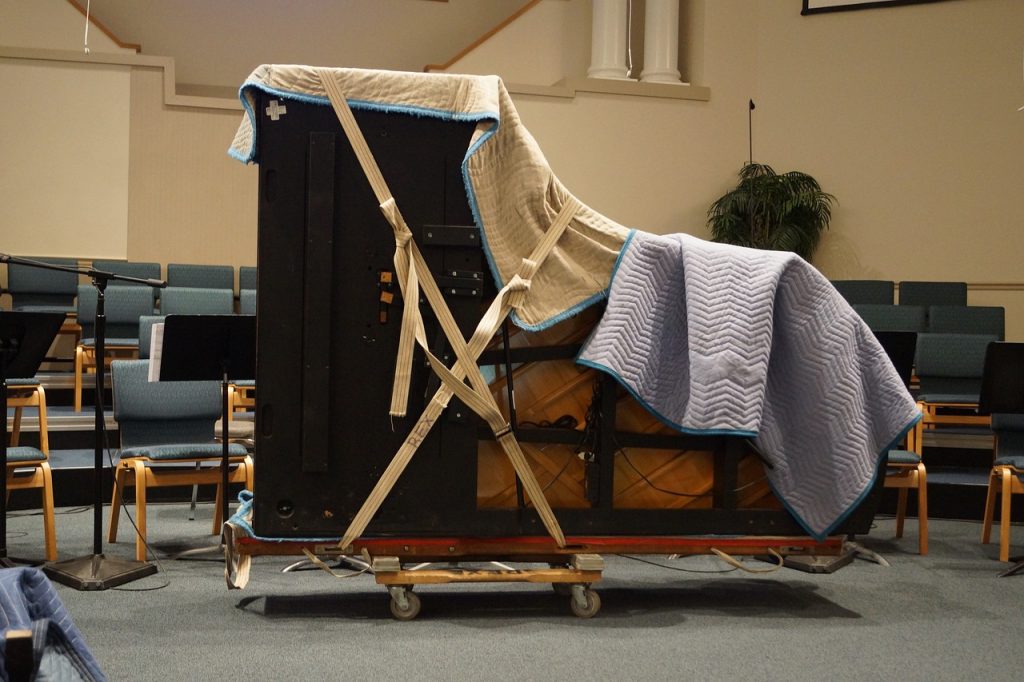A piano is great to have—and notoriously hard to move, especially if it’s a grand piano. If you’re wondering how to transport your precious piano somewhere close or somewhere far, here’s some advice on how to get ready for a move, how to move a piano yourself, and when to seek help.
Table of Contents

Preparing for a Move
Your process of transporting a piano will depend on what kind of piano you have. Some of the most common types of pianos are grand pianos, upright pianos, and digital pianos.
Digital—or electronic—pianos are the easiest to move. Upright pianos are usually medium-sized. Grand pianos can be very large, heavy, and awkwardly shaped, making them very difficult to relocate yourself.
How to Move a Digital Piano
Digital pianos are typically easy to transport since they can be disassembled. You will probably be able to unscrew the legs of the digital piano.
Ensure you do not lose any of the parts during disassembly. Additionally, keep the piano horizontal during the move, since some digital pianos may be damaged if stored vertically.
How to Move an Upright Piano Yourself
If you have an upright piano and are hoping to transport it yourself, here’s what the process will look like. First, you want to measure both the instrument and all the entryways or staircases you need to move it through. This way, you know it’ll fit. You might also want to get equipment like moving blankets, moving tape, a dolly, straps, work gloves, and a ramp for stairs.
Sometime before the move, you should take steps to prepare the instrument. Close the lid over the keys, and make sure it’s secure. You might want to wrap it in a moving blanket and tape the blanket on. Take similar measures to protect the pedals, wrapping them and securing them with tape. You can also tape a moving blanket around the piano.
Come moving day, make sure to clear all obstructions out of your path. You probably also want to lay something down on your floor to protect it during the move. Pianos are heavy, and can easily scratch hardwood floors.
Once you’re ready to move the instrument, with a team of four or five people, lift the piano onto the dolly, taking care to protect your backs. You can then navigate the piano to the final destination, perhaps using a stair ramp if you have stairs. Keep the piano upright so that you don’t inadvertently damage the strings.
As a word of advice, do not be tempted simply to wheel the piano on its casters—these are not meant for moving and can collapse. In addition, know that you will likely need to retune the piano after it reaches its final destination.
How to Move a Grand Piano Yourself
Grand pianos are often more difficult to transport than upright pianos. They might require some disassembly and a more specialized moving procedure.
Just like when you move an upright piano, make sure to measure the piano, as well as all the spaces you want to fit it through. In addition, lower and secure the piano lid.
However, for a grand piano, you should remove the pedal lyre. You can also take off one of the piano’s legs so that you can turn it on its side; movers often do this so they can fit the piano through doorways. You might be able to unscrew the legs directly, or they might be attached to the piano with screws.
When you’re ready, move the piano onto its side. Be careful as you lower the piano; this step of the move is especially likely to cause injuries. After you lift the piano on its side, you can pick it up and put it on a dolly. Make sure to position the dolly so that the piano’s weight will be evenly distributed on top of it.

Getting Help Moving a Piano
As you’ve seen, moving a piano—and especially a grand piano—can be difficult. You might want to consider getting help with the move.
There are specialized piano moving services that can take care of just your instrument, or you can hire a labor-only service like UniMovers, which will help you with the labor but spare you the expense of a truck. Relocating a piano often costs a few hundred dollars, but given the price of the instrument (and the risk of getting injured), this fee might be worth it to save you stress.
Conclusion
Now you know the basics of transporting a piano, including how to move the instrument yourself, and when to seek help. The process might seem daunting, but people move with pianos all the time, so you can definitely handle it. Remember, hiring movers to help you with your piano or other large furniture can be a big help.

Sophie Pollack-Milgate has a day job as a bioethics research assistant. In her free time, she likes to read books critiquing psychiatry, complain about how either ice or heat are ruining her runs (depending on the season), and modify recipes beyond recognition.




